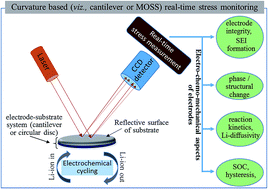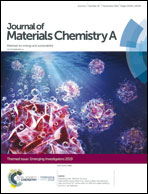Real-time monitoring of stress development during electrochemical cycling of electrode materials for Li-ion batteries: overview and perspectives
Abstract
One of the major issues associated with Li-ion batteries is the stress development in electrode materials. Such stresses arise primarily from dimensional changes, structural/phase transformations and development of Li-concentration gradients in electrode materials during electrochemical cycling. These cause drastic fade in the Li-storage capacity due to fracture/disintegration of the electrodes, especially those which possess greater Li-storage capacity. They also negatively influence some of the other electrochemical performances, such as voltage hysteresis and kinetics of Li-storage. Accordingly, such stresses lead to compromise in the energy density, power density and cycle stability of Li-ion batteries. However, evaluating and understanding the above electro-chemo-mechanical aspects via ex situ experiments are neither feasible nor reliable, because the stress state depends critically on the state-of-charge (viz., Li-content) and the surrounding conditions of the concerned electrode. Thus, in situ experiments are needed for evaluating/understanding them and eventually addressing them in comprehensive terms. In this context, over the last decade, extensive efforts have been directed towards measuring/monitoring the stress development in different electrode materials/types/architectures in real-time during electrochemical cycling. For the same, the more commonly used techniques have been based on a substrate curvature methodology, which allows fairly direct measurement of the stresses. Additionally, a host of other in situ techniques have been employed, which provide valuable complementary information on the electrode strains/stresses. The success of all the above has led to some vital understandings on the electro-chemo-mechanical aspects, which now enable the development of electrode architectures possessing enhanced integrity upon repeated electrochemical cycling. In this context, the present review introduces the types and mechanistic aspects of the concerned stresses for the first time. This is followed by details on the in situ monitoring of the stress development via variants of the substrate curvature methodology, focussing on the mechanistic aspects and different anode/cathode materials, as well as electrode architectures. The complementary information obtained from other in situ techniques is then discussed, which is followed by discussion on the inferences obtained on aspects other than the integrity of the electrodes. Finally, some of the aspects/issues that need further attention have been discussed, while summarizing the important information obtained so far from such in situ studies.

- This article is part of the themed collections: Recent Review Articles and Journal of Materials Chemistry A Emerging Investigators


 Please wait while we load your content...
Please wait while we load your content...